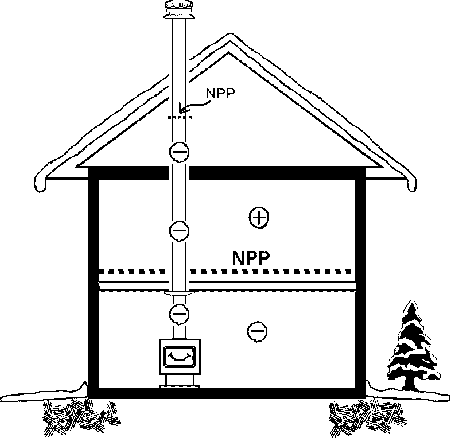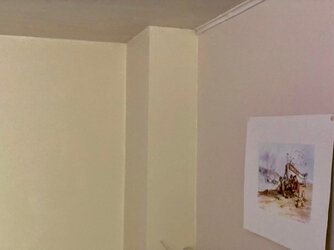I've read a lot of things about how exterior chimneys work more poorly than interior ones. If the chimney passes through the heated living space (like the upper floors of the house), then it will obviously be warmer than an exterior chimney.
What I'm having trouble pinning down is how this warmer chimney, combined with stack effects in the house and the location of the neutral pressure plane, will affect whether the (unfired standby) chimney will tend to draft air into or out of the house.
The general idea is that a warm interior chimney will tend to draft up and out during cold winter months, even when no fire is burning. But why is this true? If the stove is below the neutral pressure plane in the house, it should still suck air in, regardless of whether the chimney is warm or cold, right?
I've found three articles that kinda wave their hands about this issue:
 www.woodheat.org
www.woodheat.org

And there's one article from Jotul that shows how a tall interior chimney has a higher NPP than the house:
 www.jotul.com
www.jotul.com
They even show a diagram of this:

But this isn't explained in any great detail. What would a similar diagram look like for an exterior chimney?
It seems like the "stack effect" in the chimney itself would only work if the chimney was closed at the top, so that the pressure could build up there. And yeah, it's taller than the house, but how does this help? Even in this diagram, we're still showing negative pressure all the way down the chimney... is the idea that the pressure at the bottom of the chimney is even MORE negative than the pressure in the house? So it will suck air into the chimney from the house?
And how would this change if the chimney was exterior and colder? Maybe the whole chimney is at outside atmospheric pressure in that case?
How does total chimney height affect this? Do taller chimneys naturally suck air out of the house more? If you make your exterior chimney tall enough, will that eventually overcome the problems associated with a cold chimney? What if your exterior chimney was 3x taller than your house?
And for interior chimneys, is as tall as possible necessary, regardless of construction cost? For example, on a tall 2-story house with the woodstove on the first floor, if you have an interior chimney that exits the roof near the eves of the roof, vs. a much taller interior chimney that exits near the peak of the roof, how much better will the taller one draft than the shorter one?
(And yes, there are other problems with a cold exterior chimney, like condensation of flue gasses and build-up of deposits, but I'm just talking about draft issues here).
What I'm having trouble pinning down is how this warmer chimney, combined with stack effects in the house and the location of the neutral pressure plane, will affect whether the (unfired standby) chimney will tend to draft air into or out of the house.
The general idea is that a warm interior chimney will tend to draft up and out during cold winter months, even when no fire is burning. But why is this true? If the stove is below the neutral pressure plane in the house, it should still suck air in, regardless of whether the chimney is warm or cold, right?
I've found three articles that kinda wave their hands about this issue:
A non-commercial service in support of responsible home heating with wood - The Evil Outside Chimney
The Wood Heat Organization was formed to support the public in the responsible use of wood energy in the home. We fulfill our mandate by providing reliable information, by conducting research into wood heating-related issues and by representing the public interest in discussions of policies that...

Backdrafting | The Chimney Sweep
www.thechimneysweep.ca
And there's one article from Jotul that shows how a tall interior chimney has a higher NPP than the house:
All about wood stove chimneys | Jøtul
No Jotul woodburning stove or fireplace insert can function properly without a good chimney. Think of the chimney as the engine that drives the Jotul wood heating system. Think of its fuel as heat. Think of the power it puts out as draft. The more fuel (heat) you give this engine (chimney), the...
They even show a diagram of this:

But this isn't explained in any great detail. What would a similar diagram look like for an exterior chimney?
It seems like the "stack effect" in the chimney itself would only work if the chimney was closed at the top, so that the pressure could build up there. And yeah, it's taller than the house, but how does this help? Even in this diagram, we're still showing negative pressure all the way down the chimney... is the idea that the pressure at the bottom of the chimney is even MORE negative than the pressure in the house? So it will suck air into the chimney from the house?
And how would this change if the chimney was exterior and colder? Maybe the whole chimney is at outside atmospheric pressure in that case?
How does total chimney height affect this? Do taller chimneys naturally suck air out of the house more? If you make your exterior chimney tall enough, will that eventually overcome the problems associated with a cold chimney? What if your exterior chimney was 3x taller than your house?
And for interior chimneys, is as tall as possible necessary, regardless of construction cost? For example, on a tall 2-story house with the woodstove on the first floor, if you have an interior chimney that exits the roof near the eves of the roof, vs. a much taller interior chimney that exits near the peak of the roof, how much better will the taller one draft than the shorter one?
(And yes, there are other problems with a cold exterior chimney, like condensation of flue gasses and build-up of deposits, but I'm just talking about draft issues here).


